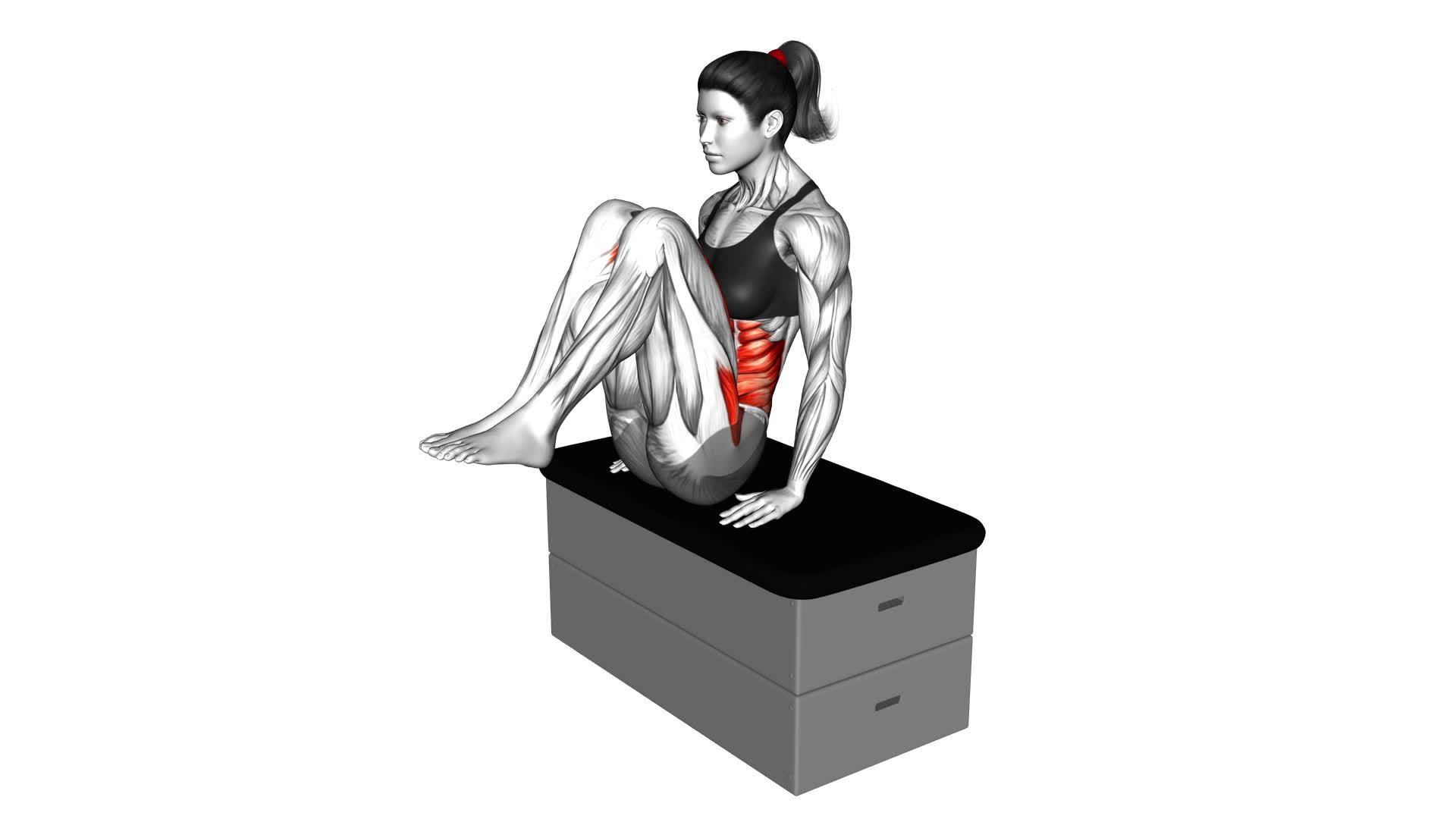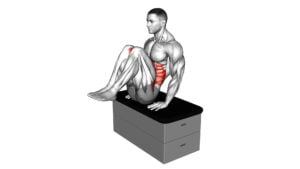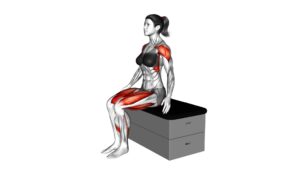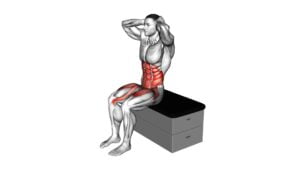Sitting in Out Leg Raise on a Padded Stool (Female) – Video Exercise Guide & Tips

Are you looking for a way to strengthen your leg muscles? Look no further than the Sitting in Out Leg Raise on a Padded Stool.
Watch This Exercise Video
This exercise targets your thighs and glutes, helping you build strength and tone in those areas.
In this video exercise guide, we'll show you the proper form and technique for this exercise, as well as variations to increase or decrease intensity.
Get ready to feel the burn and see results with this effective leg raise exercise!
Key Takeaways
- Sitting in Out Leg Raise on a Padded Stool targets hip flexors and engages core muscles for improved strength and flexibility.
- Proper form and technique involve sitting with a straight back, feet flat on the floor, and hands on the sides of the stool for support.
- Common mistakes to avoid include rounding the back, using momentum instead of muscles, and lifting legs too high or too low.
- Variations and intensity adjustments can be made by incorporating resistance bands, using an elevated platform, or adjusting the platform height, among other options.
Benefits of the Sitting in Out Leg Raise
You can experience various benefits from performing the Sitting in Out Leg Raise exercise. This exercise primarily targets your hip flexors, which are the muscles responsible for lifting your legs. By regularly incorporating this exercise into your workout routine, you can improve the strength and flexibility of your hip flexors, leading to increased mobility and range of motion in your hips and lower body.
Additionally, the Sitting in Out Leg Raise exercise engages your core muscles, including your abdominals and obliques, as they work to stabilize your body throughout the movement. This can contribute to better posture and a stronger core overall.
Furthermore, this exercise can be easily modified to suit your fitness level and goals. If you're a beginner, you can start by performing the exercise without any additional weight or resistance. As you progress, you can gradually increase the resistance by using ankle weights or resistance bands. You can also experiment with different variations, such as raising your legs to the side or crossing them over each other, to target different muscles in your hips and thighs.
Proper Form and Technique for the Exercise
To perform the Sitting in Out Leg Raise exercise with proper form and technique, follow these steps:
- Sit on a padded stool with your back straight and feet flat on the floor.
- Place your hands on the sides of the stool for support.
- Engage your core muscles by pulling your belly button towards your spine.
- Slowly lift one leg out to the side, keeping it straight and parallel to the floor.
- Pause for a moment at the top of the movement, then lower the leg back down.
- Repeat the same movement with the opposite leg.
- Continue alternating legs for the desired number of repetitions.
Proper form and technique are essential to maximize the benefits of the Sitting in Out Leg Raise exercise. By following these steps, you can ensure that you're engaging the correct muscles and avoiding common mistakes.
Some common mistakes to watch out for include:
- Allowing your back to round or hunch forward. Keep your back straight throughout the exercise to maintain proper posture.
- Using momentum to lift your legs instead of relying on your muscles. Control the movement and focus on using your leg muscles to lift and lower your legs.
- Lifting your legs too high or too low. Aim to raise your leg to a height that's comfortable for you, without straining or compromising your form.
Variations to Increase or Decrease Intensity
To increase or decrease the intensity of the sitting in out leg raise on a padded stool exercise, there are several variations you can try.
One option is to incorporate resistance bands into the exercise, which adds extra resistance and challenges your muscles.
Another variation is to use an elevated platform, such as a step or a sturdy box, to increase the range of motion and make the exercise more challenging.
Resistance Band Modifications
To increase or decrease the intensity of the Sitting in Out Leg Raise on a Padded Stool exercise, you can modify it using resistance bands. Resistance band modifications offer a great way to add or reduce resistance during this exercise, allowing you to customize the difficulty level to your specific needs.
Here are some resistance band variations to consider:
- Increased Intensity: Attach resistance bands to your ankles or thighs to add extra resistance as you raise your legs.
- Decreased Intensity: Place the resistance band around your knees instead of ankles to reduce the tension and make the exercise easier.
- Progressive Resistance: Use different levels of resistance bands to gradually increase the challenge and continuously improve your strength.
- Unilateral Resistance: Attach a resistance band to one ankle while keeping the other leg free, alternating sides to work each leg independently.
By incorporating resistance bands into the Sitting in Out Leg Raise on a Padded Stool exercise, you can effectively modify the intensity and take your workout to the next level.
Now, let's explore another modification option: elevated platform variations.
Elevated Platform Options
To vary the intensity of the Sitting in Out Leg Raise on a Padded Stool exercise, you can explore elevated platform options that allow you to increase or decrease the challenge.
By adjusting the height of the elevated platform, you can customize the difficulty level to suit your fitness goals and abilities.
If you want to increase the intensity, choose a higher platform. This will require your muscles to work harder as you lift your legs.
On the other hand, if you prefer a less challenging variation, opt for a lower platform. This will provide more stability and make it easier to perform the leg raise.
Remember to choose a platform height that allows you to maintain proper form and stability throughout the exercise.
Experiment with different options to find the ideal elevated platform height that works for you.
Tempo and Speed Adjustments
Adjusting the tempo and speed of the leg raises on a padded stool can effectively increase or decrease the intensity of the exercise. By manipulating the tempo and speed, you can target different muscle fibers and challenge your body in new ways. Here are some variations to help you control the tempo and progress the speed of your leg raises:
- Slow and controlled: Perform the leg raises at a slower pace, focusing on engaging your core and maintaining proper form throughout the movement.
- Fast and explosive: Increase the speed of your leg raises, driving your legs upward with power and speed.
- Tempo changes: Alternate between slow and fast leg raises to create a tempo contrast and challenge your muscles in different ways.
- Time under tension: Hold the leg raises at the top for a few seconds before slowly lowering your legs back down.
By adjusting the tempo and speed, you can customize the intensity of the leg raises to suit your fitness level and goals.
Now let's move on to common mistakes to avoid and ensure you get the most out of this exercise.
Common Mistakes to Avoid
Avoid making the mistake of lifting your legs too high during the sitting in out leg raise exercise on a padded stool. This is one of the common mistakes that beginners tend to make. Lifting your legs too high can put excessive strain on your lower back and may lead to discomfort or even injury. To avoid this, focus on keeping your leg movements controlled and within a comfortable range of motion.
Another common mistake to avoid is using momentum to lift your legs instead of relying on your core muscles. It's important to engage your core and use it to lift your legs, rather than relying on swinging or jerking motions. This will ensure that you're targeting the right muscles and getting the most out of the exercise.
Additionally, make sure to maintain proper posture throughout the exercise. Avoid slouching or rounding your back, as this can lead to strain on your spine. Keep your back straight and shoulders relaxed, and imagine lengthening your spine as you perform the leg raises.
Remember to start with a weight that's appropriate for your fitness level and gradually increase as you get stronger. It's better to start with lighter weights and maintain proper form than to lift heavy weights with poor form. Focus on quality over quantity, and take your time to perform each repetition correctly.
Tips for Maximizing Results
To make the most of your sitting in out leg raise exercise on a padded stool, focus on engaging your core muscles and maintaining proper form throughout.
Here are some tips for maximizing results in your workout routine:
- Begin by finding a sturdy, padded stool or chair that allows you to sit with your feet flat on the ground and your knees at a 90-degree angle. This will provide stability and support for your legs.
- Keep your back straight and your shoulders relaxed. Avoid slouching or leaning forward, as this can put unnecessary strain on your lower back.
- As you lift your legs out to the side, imagine pressing against an invisible resistance. This will help activate your outer thigh muscles and maximize the effectiveness of the exercise.
- Focus on controlled and deliberate movements. Avoid swinging your legs or using momentum to lift them higher. Instead, engage your abdominal muscles to lift and lower your legs in a controlled manner.
Sample Workout Routine Incorporating the Leg Raise Exercise
To create an effective workout routine that incorporates the leg raise exercise, there are a few key points to keep in mind.
First, determine the optimal number of leg raise reps for your fitness level and goals.
Additionally, if you're a beginner, consider starting with a modified version of the exercise to build strength gradually.
Lastly, always prioritize proper form to ensure maximum effectiveness and minimize the risk of injury.
Optimal Leg Raise Reps
Perform the leg raise exercise on a padded stool for optimal results in your workout routine. To maximize results, follow these tips:
- Start with a comfortable height for the stool and gradually increase as you get stronger.
- Aim for 2-3 sets of 10-15 reps per leg, focusing on controlled movements.
- Engage your core muscles throughout the exercise to maintain stability and balance.
- Take short breaks between sets to prevent fatigue and maintain proper form.
By incorporating the leg raise exercise into your routine and following these guidelines, you can effectively target your lower abdominal muscles and improve your overall core strength.
Now, let's move on to the next section, which will discuss a beginner variation for those who are new to this exercise.
Variation for Beginners
To start incorporating the leg raise exercise into your routine as a beginner, follow this sample workout routine that includes variations for optimal results.
As a beginner, it's important to make modifications to the exercise to suit your fitness level and to ensure proper alignment. Begin by sitting on a padded stool with your back straight and your feet flat on the floor. Place your hands on the sides of the stool for support.
Lift one leg straight out in front of you, keeping it parallel to the floor. Hold for a few seconds, then lower it back down. Repeat with the other leg. Aim to complete 10-15 repetitions on each leg, gradually increasing the number as you become more comfortable and stronger.
Remember to maintain proper alignment throughout the exercise, engaging your core for stability.
Importance of Proper Form
For optimal results and to avoid injury, it's crucial that you maintain proper form while performing the leg raise exercise on a padded stool. Here are some important tips to keep in mind:
- Keep your back straight and your core engaged throughout the exercise. This will help protect your lower back and prevent strain.
- Avoid swinging your legs or using momentum to lift them. Instead, focus on using your abdominal muscles to control the movement.
- Make sure your legs are fully extended and parallel to the floor at the top of the movement. This will ensure that you're targeting the muscles in your lower abdomen effectively.
- Control the descent of your legs and avoid letting them drop quickly. This will help you maintain control and prevent any jerky movements that could lead to injury.
Frequently Asked Questions
How Many Calories Does the Sitting in Out Leg Raise Exercise Burn?
The sitting in out leg raise exercise can help you burn calories and improve your balance. It's a great way to engage your leg muscles and work on your core strength.
By lifting your legs out to the side while sitting on a padded stool, you activate your hip abductor muscles, which can lead to increased calorie burn.
Additionally, this exercise challenges your stability, helping to improve your balance over time.
Can the Sitting in Out Leg Raise Exercise Help Improve Balance?
To improve balance, try the sitting in out leg raise exercise. This move targets your leg strength and helps stabilize your body.
By sitting on a padded stool and raising your legs out to the sides, you engage your core and challenge your stability.
It's important to maintain proper form and control throughout the exercise. Practice regularly and gradually increase the difficulty to see progress in your balance and leg strength.
Is It Necessary to Use a Padded Stool for This Exercise, or Can Any Sturdy Chair Be Used?
To properly perform the sitting in out leg raise exercise, it's important to have a stable surface to sit on. While a padded stool is recommended, any sturdy chair can be used as an alternative.
The focus should be on maintaining balance and engaging the muscles in your legs and core. By using a padded stool or sturdy chair, you can ensure a safe and effective workout that targets your lower body.
Can the Sitting in Out Leg Raise Exercise Be Modified for Individuals With Lower Back Pain?
If you're dealing with lower back pain, there are modification options for the sitting in out leg raise exercise. Instead of using a padded stool, you can try using a sturdy chair with a cushion.
Additionally, you can perform alternative exercises that target the same muscle groups without putting strain on your lower back.
Remember to listen to your body and consult with a professional if needed. Keep your health and safety a priority.
How Long Should One Hold the Raised Leg Position During the Exercise?
To properly perform the sitting in out leg raise exercise, it's important to know how long to hold the raised leg position. Without the context of the exercise, the general rule is to hold the raised leg position for a few seconds, ensuring that you maintain proper form throughout.
However, to progress the exercise and challenge yourself, you can gradually increase the duration of the hold. Remember to listen to your body and never push yourself beyond your limits to avoid injury.
Conclusion
Incorporating the sitting in out leg raise into your workout routine can offer numerous benefits, including strengthening and toning your leg muscles. By following proper form and technique, you can maximize the effectiveness of this exercise.
Additionally, adjusting the intensity and avoiding common mistakes will help you achieve better results. Remember to consult with a fitness professional before starting any new exercise program.
Stay consistent and enjoy the benefits of this challenging leg raise exercise.

Author
Years ago, the spark of my life’s passion ignited in my mind the moment I stepped into the local gym for the first time. The inaugural bead of perspiration, the initial endeavor, the very first surge of endorphins, and a sense of pride that washed over me post-workout marked the beginning of my deep-seated interest in strength sports, fitness, and sports nutrition. This very curiosity blossomed rapidly into a profound fascination, propelling me to earn a Master’s degree in Physical Education from the Academy of Physical Education in Krakow, followed by a Sports Manager diploma from the Jagiellonian University. My journey of growth led me to gain more specialized qualifications, such as being a certified personal trainer with a focus on sports dietetics, a lifeguard, and an instructor for wellness and corrective gymnastics. Theoretical knowledge paired seamlessly with practical experience, reinforcing my belief that the transformation of individuals under my guidance was also a reflection of my personal growth. This belief holds true even today. Each day, I strive to push the boundaries and explore new realms. These realms gently elevate me to greater heights. The unique combination of passion for my field and the continuous quest for growth fuels my drive to break new ground.



